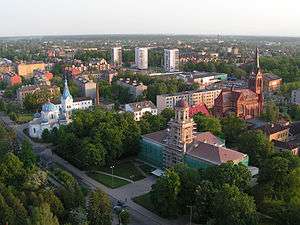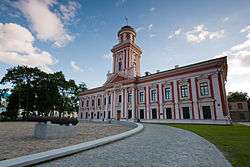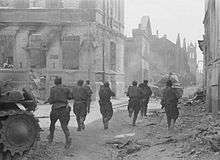Jelgava
Jelgava (pronounced [jælɡava] (![]()
Jelgava | |
|---|---|
City | |
 Aerial view of Jelgava | |
 Flag  Greater Coat of arms  Coat of arms | |
 Jelgava Location in Latvia | |
| Coordinates: 56°38′54″N 23°42′50″E | |
| Country | |
| Town rights | 1573 |
| Government | |
| • Mayor | Andris Rāviņš[1] |
| • Number of city council members | 15 |
| Area | |
| • Total | 60 km2 (20 sq mi) |
| • Water | 2.34 km2 (0.90 sq mi) |
| Elevation | 13 m (43 ft) |
| Population (1 January 2020)[2] | |
| • Total | 56,062 |
| • Density | 930/km2 (2,400/sq mi) |
| Time zone | UTC+2 (EET) |
| • Summer (DST) | UTC+3 (EEST) |
| Postal code | LV-300(1–9); LV-3024; LV-3035 |
| Calling code | (+371) 630 |
| Website | www |



Jelgava is situated on a fertile plain rising only 3.5 metres (11.5 feet) above mean sea level on the right bank of the river Lielupe. At high water the plain and sometimes the town as well can be flooded. It is a railway center and is also host to Jelgava Air Base. Its importance as a railway centre can be seen by the fact that it lies at the junction of over 6 railway lines connecting Riga to Lithuania, eastern and western Latvia, and Lithuania to the Baltic sea.
Name
Until 1917, the city was officially referred to as Mitau. The name Jelgava is believed to be derived from the Livonian word jālgab, meaning "town on the river."[3] The origin of the German name Mitau is unclear, although it is suggested that it came from the Latvian words mīt or mainīt, meaning "to exchange" or "to trade," thus making it "trading-place." An alternate explanation is that Mitau came from Mitte in der Aue, German for "the middle of the Aa", referring to the Lielupe River, formerly known as the Courland Aa (Kurländische Aa in German).
History
The Livonian settlement Jelgava began developing between the rivers Lielupe and Driksa during the 10th century. Led by the Grand Master Konrad von Mandern, the crusading Livonian Order constructed the castle in Mitau on a natural island fortification (Pilssala) in 1265–1266. Using Mitau as a southern fortress, the German knights subdued the surrounding Livonians and Semigallians by 1290. The town rose in importance as a defensive fixture against the Lithuanians to the south, who succeeded in plundering Jelgava in 1345.
As a result of the fall of the Livonian Order in the Livonian War, Mitau became a town of the Duchy of Courland in 1561. Jelgava received city rights in 1573, and became the capital of the united duchies of Courland and Semigallia in 1578. When the Duchy of Courland split in 1596, Jelgava became the residence of Duke Friedrich Kettler of Semigallia. The city again became the capital of the united duchies in 1617. Because the duchy became a vassal of the Polish-Lithuanian Commonwealth, Jelgava was also referred to by the Polish name Mitawa. The Commonwealth's repeated wars with Sweden subjected Jelgava to several sieges. Despite the wars, the city grew as a center for trade and industry. As Courland's neighbors increased in strength, however, the duchy and Jelgava began to fall under Russia's sphere of influence; Carl Christian Joseph of Saxony, Duke of Courland had to abdicate under Russian siege in 1763. The duchess from 1711 to 1730 was Anna Ivanovna, later Empress Anna I of Russia.
The penultimate duke of Courland, Ernst Johann von Biron, expanded the cultural aspects of Jelgava. He constructed the ducal palace and opened the first public library in the city. In 1775 the last Duke of Courland, Peter von Biron, founded the Academia Petrina, which became a cultural center for the country. The duke also encouraged theatrical performances at his court.

With the outbreak of the French Revolution in 1789, the citizens of Jelgava clamored for more rights. However, Imperial Russia annexed the city with Courland in 1795 during the Partitions of Poland. As the seat of the Count of Provence, the palace of Jelgava was the residence (1798–1801 and 1804–1807) of Louis XVIII before he became the French king. Although the city was occupied by Prussian troops during the Napoleonic Wars, it was largely spared destruction.
Jelgava further expanded after the construction of its railway in 1868. The development of its infrastructure encouraged rural Latvians to migrate to the city, as merchants, craftsmen, teachers, and officials. By 1914 Jelgava had over 45,000 inhabitants. However, Jelgava suffered considerably after the outbreak of World War I. The spirited defence of Jelgava by two battalions of the Latvian Home Guard in 1915, helped inspire the formation of the Latvian Rifles. German troops occupied the city during the war, and British prisoners of war, sent there as forced labour, suffered atrocious conditions and treatment.[4] After the war, in 1919, Jelgava became a battleground between Bolshevik Red Guards, German paramilitaries, and Latvian freedom fighters. After the latter's victory in November 1919, Jelgava became an important city in independent Latvia. In 1925 a sugar factory was built in Jelgava, the first such factory in Latvia. In 1939 Latvia University of Life Sciences and Technologies was opened in Jelgava Palace.
As a result of the Nazi-Soviet Pact, Jelgava was occupied and annexed with the rest of Latvia by the Soviet Union in 1940 during World War II. Much of the city's remaining German population were resettled into the territory of German occupied Poland during the Nazi–Soviet population transfers. German forces from Army Group North occupied Jelgava from 1941 to 1944 until the capture of the city by the Red Army. During the war, German police along with Latvian auxiliary police murdered the Jewish inhabitants of the city during a series of mass shootings (see Jelgava massacres). The main synagogue was burned to the ground.
In late July 1944, the Soviet Red army launched an attack from the south in the direction of Jelgava and Tukums to encircle the German Army Group North. Jelgava was declared a fortress (Festung) however, there were only a few scattered German and Latvian units in the city. From 30 July until 7 August, after heavy street fighting and several air raids, the Red Army managed to occupy the left bank of the Lielupe river. In late August, the German army launched a counterattack on Jelgava from the north but it failed to drive back the Soviets. Jelgava remained on the frontline until 10 October when the German army retreated to Courland. The city's historic centre, industry, rail network, and public buildings were heavily damaged by the fighting, with almost 90% of the city destroyed. Among lost buildings was famous Kurland Provincial Museum and Athenaeum.

Jelgava was rebuilt in typical Soviet style after World War II as part of the Latvian SSR. Jelgava became home to several big factories. Among them were the sugar factory, which was heavily expanded from 1975 assembly line, and administration buildings for the Riga Autobus Factory (RAF). Following Latvian independence, Jelgava has slowly regained its original Germanic heritage and is now a popular tourist site. Owing to Latvia University of Life Sciences and Technologies, many of Jelgava's inhabitants are students or people connected with education. For this reason Jelgava is sometimes called the Student capital of Latvia.
Demographics
As of 1 January 2017, the city had a population of 61,308.
Sights
Jelgava before the Second World War had regular, broad streets lined with the mansions of the Baltic German nobility who resided at the former capital of Courland. The old castle (1266) of the dukes of Courland, situated on an island in the river, was destroyed by Duke Biren, who had a spacious palace erected (1738–1772) by Bartolomeo Rastrelli at the bridge across the Lielupe. The palace contains the sarcophagi of almost all of the Curonian dukes, except the last one. The future Louis XVIII sojourned in the palace between 1798 and 1800. It now functions as Latvia University of Life Sciences and Technologies. Other landmarks include the Baroque church of St. Anne's Church (Liela Street 22a), the tower of the destroyed Jelgava St. Trinity Church (Akadēmijas Street 1), and two handsome structures: the Villa Medem and the Academia Petrina.
in addition the following cultural and historical objects can be seen: Jelgava Castle (Lielā Street 2), Jelgava Old Town, St. Mary's Cathedral of the Immaculate Conception (Katoļu Street 11), St. Simeon and St. Anna Orthodox Cathedral (Raina Street 5), St. John's Church (Jāņa Street 1), Jelgava Baptist Church (Matera Street 54), Love Alley (Dobele highway), Valdeka Castle (Rīgas Street 22), Jelgava Station (Stacijas Street 1).
Culture
.jpg)
Jelgava regularly hosts an international Ice Sculpture festival, Student Folk Festival, Easter Walk, Latvian Plant Days, Business Days, Jelgava City Festival, Summer solstice in Jelgava, medicine market, International Cat Show "Jelgava Cat" , Sports Day, International Sand Sculpture Festival, Latvian Milk, Bread and Honey Festival and Milk Packet Boat Regatta, Beginning of the School Year, Metal Festival, Azemitologa Festival[5], Autumn fair " Miķeļdienas waiting", Latvian Amateur Theater Festival "Jokes come from the actor", Student Days, Proclamation Day of the Republic of Latvia s celebrations, New Year's Eve.
The following museums operate in the city: Ģederts Eliass Jelgava History and Art Museum, Adolf Alunan Memorial Museum, historical expositions Trinity Church tower, Latvia University of Agriculture Museum, Rundāle Castle museum exposition in Jelgava Castle "Tombs of the Dukes of Kurzeme and Zemgale", Latvian Railway Museum Jelgava exposition, psychiatric hospitals "Ģintermuiža" museum, Firefighter exposition.
Libraries: Jelgava City Library (Akadēmijas Street 26), Pārlielupe Library (Loka highway 17), Miezīte Library (Dobele highway 100), children's library "Zinītis" (Lielā Street 15).
Parks
Green territories and parks: Jelgava Castle Park, Station Park, Rainis Park, Duke Jacob's Square, Square in Mātera Street, Alunāns Park, Svētbirze, Ozolpils Park, Valdeka Park, Ozolskers, Victory Park, Jelgava Psychoneurological Hospital Park, Lielupe floodplain meadows, Grēbner Park, forest near RAF residential area, forest near Jelgava bypass.
Sports
The city's main football team, FK Jelgava, plays in the Latvian Higher League and has won the Latvian Football Cup four times.
Notable people
- Aleksejs Auziņš (1910–1997) – footballer, coach, ice hockey player
- Johann Heinrich Baumann (1753-1832) - painter
- August Johann Gottfried Bielenstein (1826–1907) – linguist, folklorist, ethnographer
- Peter von Biron (1724-1800), Duke of Courland
- Vilnis Edvīns Bresis (1938-2017), politician
- Jan Krzysztof Damel (1780-1840), painter
- Andrejs Dūda (born 1981), swimmer
- Karl Eichwald (1795–1876), geologist, paleontologist and physician
- Johannes Engelmann (1832-1912), jurist
- Ieva Gaile (born 1997), figure skater
- Kristīne Gaile (born 1997), figure skater
- Kaspars Gerhards (born 1969), politician
- Johannes von Guenther (1886–1973), writer
- Joseph Hirshhorn (1899–1981), entrepreneur, financier and art collector
- Olga Jakušina (born 1997), ice dancer
- Elise von Jung-Stilling (1829-1904), painter
- Edijs Jurēvics (born 1989), rocksinger and guitarist
- Renārs Kaupers (1974), Latvian singer
- Friedrich Kettler (1569-1642), Duke of Courland
- Frederick Casimir Kettler (1650-1698), Duke of Courland
- Ferdinand Kettler (1655-1737), Duke of Courland
- Frederick William, Duke of Courland (1692-1711), Duke of Courland
- Maria Amalia of Courland (1653-1711), Landgravine of Hesse-Kassel
- Wilhelm Kettler (1574-1640), Duke of Courland
- Adolph Theodor Kupffer (1799-1865), chemist, and physicist
- Dzintars Lācis (1940-1992), cyclist
- Natalia Laschenova (1973) Olympic team gold medalist (gymnastics)
- Max Lazerson (1887-1951), politician
- Gustav Leibson (1876–1947), Merchant. Grandfather of British politician Nigel Lawson, Baron Lawson of Blaby
- Friedrich Ludwig Lindner (1772-1845), German writer, journalist and physician
- Jānis Lūsis (1939), Latvian (and Soviet) athlete — javelin thrower
- Paul von Medem (1800-1854), diplomat
- Friedrich von der Pahlen (1780-1863), diplomat and administrator.
- Elza Radziņa (1917–2005), Latvian actress
- Johann Friedrich von Recke (1764-1846), senior public official in the Baltic Germans Duchy of Courland.
- Einars Repše (1961), Latvian politician
- Friedrich von Rüdiger (1783-1856), Baltic German military officer in service of the Russian Empire and a general of the Imperial Russian Army.
- Princess Pauline, Duchess of Sagan (1782-1845), Duchess of Sagan
- Princess Wilhelmine, Duchess of Sagan (1781-1839), Duchess of Sagan
- Vitālijs Samoļins (born 1990), chess player
- Igors Šaplavskis (born 1968), boxer
- Carl Christian Joseph of Saxony, Duke of Courland and Semigallia (1759–1763)
- Paul Schiemann (1876–1944), journalist, editor and politician
- Carl Schmidt (1822-1894), chemist
- Artūrs Skrastiņš (1974), stage and film actor
- Gatis Sprukts (born 1996), ice hockey player
- Mamert Stankiewicz (1889–1939), the captain of the Polish merchant marine
- Feodor Stepanovich Rojankovsky (1891–1970), illustrator
- Eduard Totleben (1818–1884), Russian military engineer
- Ernst Rudolf von Trautvetter (1809-1889), botanist
- Gunars Upatnieks (born 1983), musician
- Inese Vaidere (born 1952), politician
- Johann Walter-Kurau (1869-1932), painter
- Kaspars Znotiņš (1975), stage and film actor
Twin towns – sister cities
Jelgava is twinned with:[6]
















See also
- Adolfa Alunāna Theatre
- Jelgava massacres
References
- Jelgava City municipality web page Archived 30 September 2011 at the Wayback Machine
- "Iedzīvotāju skaits pašvaldībās". data.csb.gov.lv. Retrieved 17 June 2019.
- Bilmanis, Alfred (1 November 2008). "Latvia as an Independent State". Read Books – via Google Books.
- Meeting the Enemy by Richard Van Emden
- (in Latvian) LLU pirmkursnieki svin Azemitologa svētkus
- "Sadraudzības pilsētas". jelgava.lv (in Latvian). Jelgava. Retrieved 30 August 2019.
External links
| Wikivoyage has a travel guide for Jelgava. |
| Wikisource has the text of the 1911 Encyclopædia Britannica article Mitau. |